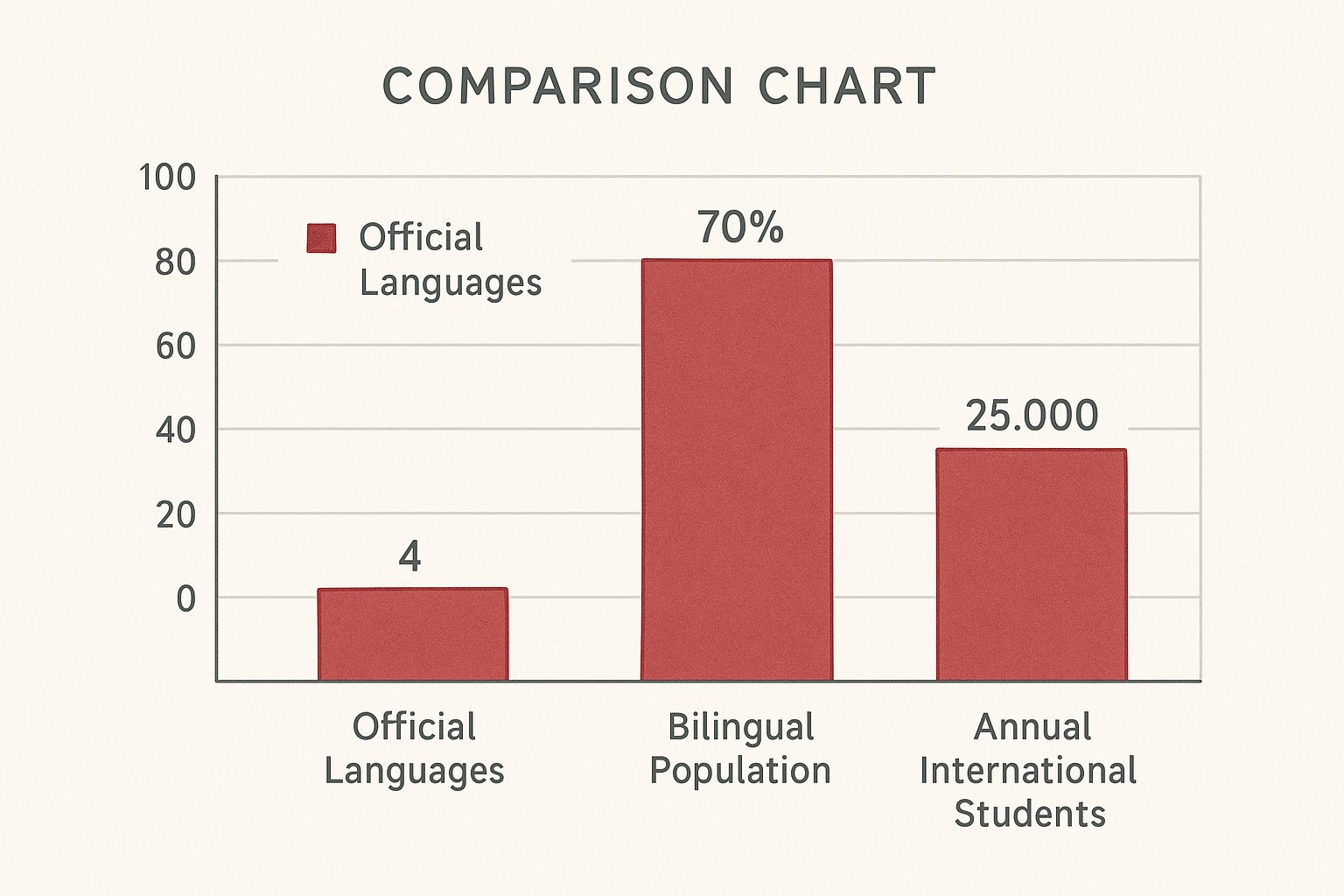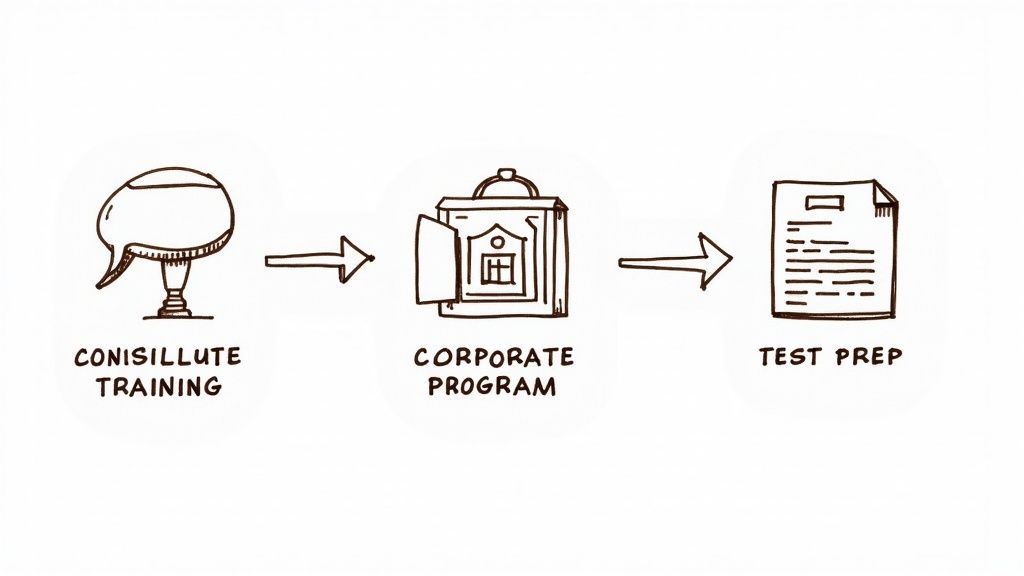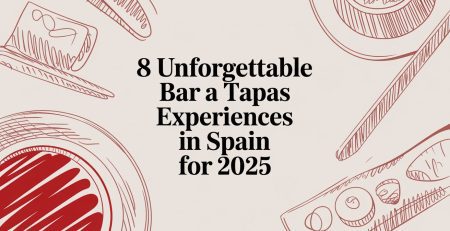Choosing a Language School in Singapore
Picking a language school in Singapore gives you a real edge. The city is a multilingual melting pot and a global business powerhouse, which creates a uniquely immersive atmosphere for learning. With its high educational standards and rich cultural backdrop, you get authentic practice opportunities everywhere, making it the perfect place to get fluent in languages like Mandarin, English, or Japanese.
Why Singapore Is a Global Hub for Language Learning
Singapore's reputation as a world-class education destination absolutely extends to language learning. This island isn't just a place to study a language in a classroom; it’s a living laboratory where you can sharpen your skills every single day in real-world situations. That hands-on quality is what truly sets it apart.
The city itself is woven from a multilingual fabric. With four official languages—English, Mandarin, Malay, and Tamil—and a population that easily switches between them, you're constantly surrounded by authentic conversations. This multicultural setting gives you endless chances to practise speaking and listening, whether you're ordering a coffee at a local kopitiam or navigating a bustling hawker centre.
On top of that, Singapore is a major hub for international business and finance, drawing professionals and students from all over the world. This creates a diverse community where languages like Japanese, Korean, French, and German aren't just academic subjects—they're practical tools used daily in business meetings and social gatherings.
This infographic lays out some key data points that highlight Singapore's unique linguistic landscape.
The mix of a bilingual local population and a large international community makes for a dynamic and supportive environment for anyone attending a language school in Singapore.
A Foundation Built on Educational Excellence
The high quality of language schools here is backed by Singapore’s famously robust educational framework. The nation's intense focus on academic rigour means that language institutions are held to incredibly high standards for their teaching methods and curriculum design.
Consider this: as of 2021, Singapore's literacy rate for residents aged 15 and over stood at an impressive 97.6%. That number speaks volumes about the value society here places on education. This commitment means you'll find structured, effective programmes, whether you're a professional looking for corporate training or a student prepping for university. For language learners, even exploring Singapore's premier arts and culture hub can offer invaluable insights into the local culture.
Singapore’s unique blend of Eastern and Western cultures offers more than just language practice; it provides deep cultural context, which is crucial for achieving true fluency.
Diverse Learning Opportunities for Every Goal
The variety of courses available is massive. You can find everything from intensive immersion programmes for Mandarin to specialised business English courses designed for corporate executives and even prep classes for official proficiency exams.
Many learners also choose to tackle languages with significant global reach. It's worth checking out our guide on the many countries that speak Spanish to see just how important it is worldwide. Ultimately, this sheer variety ensures that every learner can find a path that perfectly matches their personal, academic, or professional goals.
Comparing the Top Language Schools in Singapore
Choosing the right language school in Singapore means looking beyond the glossy brochures. You need to get to grips with what really makes each place tick. The best schools here don't just drill vocabulary; they offer completely different learning journeys, whether you’re after conversational fluency for daily life, a professional certificate for your career, or top marks in an exam.
To make sense of the options, it helps to group Singapore's language schools into three main camps based on what they do best. This approach cuts through the noise and points you towards a school that actually matches your goals.
Schools Focused on Immersive Conversation
These schools are all about practical, real-world communication. Forget dry grammar drills; their entire method revolves around interactive dialogue, role-playing, and getting a feel for the culture. The aim is to get you speaking confidently from day one.
Picture a Mandarin class where you spend less time on rote memorisation and more time acting out a trip to a wet market. This hands-on approach is perfect for expatriates, frequent travellers, or anyone who just wants to connect with people. To make it work, class sizes are kept small, usually around 4–8 students, so everyone gets a chance to talk.
The real standout feature of immersive schools is their "learning by doing" philosophy. Success isn't measured by a test score, but by whether you can hold a proper conversation once you step outside the classroom.
Institutions Specialising in Corporate Training
Then you have the schools that cater specifically to the business world. Their programmes are built to give professionals the exact language they need to get the job done—think negotiating a contract in Japanese, giving a presentation in English, or managing a team in Mandarin.
These courses are almost always tailored to the client. A bank might need a course on German for finance, while a tech start-up could ask for Spanish focused on sales jargon. The instructors here are usually a blend of language expert and industry veteran, so what you learn is immediately useful back at the office. This makes them the top choice for anyone looking to get ahead at work or for companies upskilling their teams.
Centres for Academic and Exam Preparation
The third category is for the serious student. These schools are known for their academic discipline and laser-focus on exam preparation. If you need to pass an official proficiency test like the DELE (Spanish), JLPT (Japanese), or HSK (Mandarin), this is where you go.
Their curriculum is mapped directly onto the official exam syllabus, covering all the required grammar, vocabulary, and test-taking tricks. The teaching style is often more structured and systematic, leaving no stone unturned. This rigorous approach thrives in an environment where educational achievement is highly valued, a cornerstone of Singapore's education system. You can explore this further by reading about the local international schools market.
To give you a clearer picture of how these schools stack up, here’s a quick summary.
Quick Comparison of Leading Singapore Language Schools
The table below breaks down the core focus of each type of language school, helping you see at a glance which one aligns with your personal learning needs.
| School Name | Key Languages | Primary Teaching Method | Best For |
|---|---|---|---|
| Immersive Schools | Mandarin, Spanish, Japanese | Communicative, Task-Based | Expats, Travellers, Social Learners |
| Corporate Trainers | English, Mandarin, German | Customised, Industry-Specific | Professionals, Executives, Companies |
| Exam Centres | Japanese, Spanish, French, Korean | Grammar-Focused, Syllabus-Driven | Students, Academics, Certification Seekers |
Ultimately, the best language school in Singapore for you is the one that fits your goals and learning style. Figure out what’s driving you—is it making friends, climbing the career ladder, or passing an exam? Once you know that, you can find a school that will genuinely help you succeed.
Looking Under the Hood: Course Structures and Teaching Styles
The curriculum and teaching style of a language school in Singapore are where the rubber meets the road—this will shape your entire learning experience. Two schools teaching the exact same language can feel worlds apart, so it’s crucial to look beyond the marketing blurbs and get a real sense of their educational philosophy. It’s all about finding a school that clicks with how you actually learn.
Some schools are quite traditional, favouring a grammar-heavy approach. Lessons are built methodically around rules, verb tables, and sentence deconstruction. This systematic path really suits learners who love structure and logic, giving them a rock-solid foundation for further study or academic exams.
On the flip side, many modern schools have embraced a communicative, immersive style. The focus here is on actually using the language from day one, even if it’s not perfect. The goal is to build your confidence and get you speaking in real-world situations as quickly as possible.
The Communicative vs The Grammar-Translation Method
The communicative approach is all about interaction. Think of it this way: the goal is to communicate, and the way you get there is by communicating. Classes are energetic and full of role-playing, group chats, and activities that mirror real life. A beginner class might have you practising how to order a coffee or ask for directions.
In contrast, the grammar-translation method is more analytical. You’ll likely spend time translating texts, breaking down sentences, and working through written exercises. While it might sound a bit old-school, this method is fantastic for getting to grips with complex grammar and is a core part of most serious exam prep courses.
At its core, the difference is about the main objective in the classroom. Is it to analyse the language or to use it? A communicative class measures success by whether you can get your point across, while a grammar-focused one measures it by how accurately you follow the rules.
Curriculum Design and Real-World Application
A school's curriculum tells you what it truly values. One place might weave cultural workshops into its lessons, teaching you Japanese through the art of ikebana (flower arranging) or Spanish by hosting a tapas-making class. This makes the language stick because it’s tied to a memorable, meaningful experience.
Another school might design its syllabus entirely around professional development. You'll find entire modules on business negotiation or presentation skills, complete with industry-specific jargon and role-playing scenarios you’d actually encounter at work. This is the clearest sign of whether a school is geared towards career growth or cultural enrichment.
And for schools offering online or hybrid classes, it’s worth noting that following online education best practices is what separates a frustrating digital experience from an engaging and effective one.
Specialised Courses and Learning Outcomes
Beyond the standard classes, many schools offer specialised tracks for specific goals. Picking the right one is all about knowing what you want to achieve.
- Exam Preparation Courses (DELE, JLPT, HSK): These are hyper-focused on one thing: passing the test. The curriculum is a deep dive into the specific grammar, vocabulary, and strategies you need to hit your target score.
- Business Language Programmes: Designed for professionals, these courses go beyond basic conversation to teach corporate etiquette and communication. The outcome is practical—being able to lead a meeting or write a formal email in another language.
- Language for Young Learners: Programmes for kids are all about fun. They use games, songs, and interactive play to build a natural, positive connection to the language right from the start.
For many people, particularly those jumping into Romance languages, it helps to know what you’re in for. Getting some context on whether, for example, Spanish is easy to learn can help you set realistic goals. This kind of insight gives you a better starting point as you choose your language school in Singapore.
Choosing Between Online and In-Person Classes
Today's learning landscape gives you more options than ever. When you’re picking a language school in Singapore, one of the biggest calls you'll make is whether to show up in person or log in from home. There’s no single right answer here—the best choice really comes down to your lifestyle, how you learn best, and what you want to achieve.
Online learning has absolutely exploded, thanks to its sheer convenience and some pretty slick tech. This isn't just a feeling; Singapore's online education market is booming. It's projected to grow at a Compound Annual Growth Rate (CAGR) of 13.84% between 2023 and 2033, on its way to a $4.83 billion valuation. This surge is backed by strong government support for digital infrastructure, so you can expect a quality experience. You can read more about Singapore's online education market growth on digitaldefynd.com.
This digital shift offers incredible flexibility, but it’s worth weighing that against what you can only get from face-to-face classes.
The Case for In-Person Classes
There's a certain magic to a physical classroom that's tough to capture online. For a lot of people, that social spark is everything.
Being in the same room with a native-speaking teacher and other learners creates a lively, responsive environment. You pick up on body language, get instant corrections, and fall into spontaneous conversations that just don't happen the same way through a screen.
The biggest win for in-person classes is the community you build. If you're an expat or new to Singapore, a language class can be an amazing way to meet people, grow your social circle, and practise your new skills in a supportive, real-world setting.
In-person classes are a great fit if you:
- Feed off the energy of a group and love social interaction.
- Need a fixed schedule to keep you on track and motivated.
- Appreciate the subtle cues and immediate feedback from a teacher who's right there.
- Are hoping to build a community and make new friends.
These classes often throw in cultural activities, too—think cooking nights or movie screenings—that give you a real, hands-on feel for the culture behind the language.
The Advantages of Online Learning
On the flip side, online courses offer a level of flexibility and accessibility that can be a game-changer for busy professionals, parents, or anyone with a packed schedule.
You can learn from anywhere, which means no more battling traffic on the way to class. It lets you squeeze in a lesson during your lunch break or after the kids are in bed. This format also opens up a much wider pool of instructors, so you're not limited to who's available in your neighbourhood.
Online learning is probably for you if you:
- Need a flexible schedule to juggle work or family life.
- Are self-disciplined and comfortable using digital tools.
- Want to save time and money on commuting.
- Prefer the focused, one-on-one attention you can get from a private online tutor.
Modern online platforms are no longer just video calls. They often come with interactive whiteboards, breakout rooms, and other tools designed to make the sessions more dynamic.
Making the Right Decision for You
So, how do you choose? Think about what's driving you. Are you an executive who needs to nail business Mandarin for work? An online course with a flexible schedule is probably your best bet. Or are you a new expat hoping to learn Spanish and meet new people? In-person group classes will give you that social immersion you’re looking for. You could also supplement your learning with something like a language exchange in Singapore.
Ultimately, the best language school in Singapore for you is the one that fits into your life, not the other way around. Choose the format that removes the hurdles and keeps you consistently showing up on your path to fluency.
Understanding the True Cost and Value
When you're searching for a language school in Singapore, it's easy to get fixated on the course fees. But while your budget is obviously important, that headline price is just the starting point. The real challenge is to look past the initial number and figure out the total investment versus the actual value you’ll get out of it.
A cheaper course might look tempting on paper, but it could mean you're stuck in a massive class with a less experienced teacher and flimsy learning materials. On the flip side, the most expensive school isn't always the best. The sweet spot is finding that perfect balance between what you pay and what you get—from tangible perks like tiny class sizes to the feeling of being part of a great learning community.
Breaking Down the Total Investment
That advertised course fee is your baseline, but it's almost never the final amount you'll pay. To really understand what you're in for, you need to account for all the little extras that can pop up. A smart budget looks at everything.
Keep an eye out for these potential add-ons:
- Registration and Administrative Fees: Almost every school has a one-time fee just for signing up.
- Course Materials: Are textbooks, workbooks, and access to online resources included? Sometimes they aren't, and that can add another $50 to $150 to your bill for each level.
- Exam and Certification Fees: If you're working towards an official qualification like the DELE for Spanish or the JLPT for Japanese, the exam fee is a separate cost you'll have to cover.
- Supplementary Workshops: Some schools offer cool extras like cultural workshops or conversation clubs, but they might cost more. They're great for learning but will bump up your total spend.
Asking about these costs right from the start means no nasty surprises later on, and you'll be able to make a much fairer comparison between your options.
Connecting Price to Tangible Value Drivers
Once you have a clear idea of the total cost, it's time to see what your money actually buys you. This is where you connect the price tag to the quality of the teaching. A slightly higher hourly rate at one school could be completely justified if it delivers where it counts.
True value isn't about finding the cheapest option; it’s about finding the most effective learning environment for your specific goals. An investment in smaller classes or more experienced teachers often pays for itself through faster progress and greater confidence.
Think about how schools measure up on these key points. One school might cap its classes at just 4-6 students. That’s a massive advantage, guaranteeing you get plenty of time to actually speak and receive direct feedback from your teacher—perfect if you want to become fluent quickly.
Another huge factor is the instructors themselves. Are they native speakers? Do they have professional teaching certificates? A skilled, qualified teacher can completely change your learning experience, giving you much deeper insights into both the language and the culture behind it. The table below gives you a sense of how different schools balance their costs and value.
Cost and Value Analysis of Language Courses
This table breaks down what you can generally expect from different types of language courses in Singapore, helping you identify where you'll get the best return on your investment.
| School Type | Average Price Range (per course) | Key Inclusions | Best Value For |
|---|---|---|---|
| Boutique & Specialised | S$600 – S$1200 | Small classes (4-8), native & certified teachers, cultural events. | Learners seeking personalised attention and rapid progress. |
| Large Language Centres | S$450 – S$800 | Standard curriculum, online portals, a wider range of schedules. | Students who want flexibility and a structured, standardised path. |
| Community Clubs | S$150 – S$300 | Basic conversational practice, large groups, social focus. | Hobbyists and casual learners on a tight budget. |
Ultimately, the best language school in Singapore for you is the one where the price makes sense for the things that matter most to your personal learning style and goals.
A Practical Framework for Making Your Decision
All the comparisons come down to one thing: which language school in Singapore is the right one for you? Moving from all this information to a final decision requires a bit of a personal game plan. This is where we turn our detailed breakdown into a clear path that gets you into the perfect classroom.
The whole process starts with some honest self-reflection. The single most important step is figuring out your "why," because that reason will shape every choice you make from here on out. Are you learning for your career, for travel, or just for the love of it?
Define Your Primary Objective
Pinpointing your main goal is the fastest way to narrow down the field. Get really specific with yourself about what you’re trying to achieve—it’ll tell you exactly what kind of teaching style and curriculum will actually help.
Think about which of these sounds most like you:
- For Career Advancement: You need job-specific language for meetings, emails, or dealing with clients. In this case, you should be looking squarely at schools with strong corporate training programmes.
- For Academic or Official Certification: Your target is a specific exam like the JLPT, DELE, or HSK. You’ll need a school known for its rigorous, exam-focused curriculum and proven pass rates.
- For Social Integration and Travel: You just want to connect with locals, order food without pointing, and feel confident in daily conversations. An immersive, conversation-heavy school is going to be your best bet.
- For Personal Enrichment: You're doing this for the pure joy of learning and connecting with a new culture. A school that offers cultural workshops and has a vibrant community feel would be a fantastic fit.
Your reason for learning is your compass. A professional needing business fluency has completely different needs from a student cramming for an exam. Let your goal lead the way, and you'll find a school that delivers the results you’re after.
Create Your Shortlist and Ask the Right Questions
Once you know your main objective, go back to our comparisons and pick two or three schools that seem to tick the right boxes. Now it’s time to reach out to them. A trial class or a quick chat is your chance to see past the marketing and figure out if their approach truly lines up with what you need.
When you get in touch, have a few smart questions ready to go:
- What’s the absolute maximum class size for the course I'm looking at?
- Can you tell me a bit about the teachers for this level? What are their qualifications and background?
- Are all the materials—textbooks, online access, everything—included in the course fee?
- How do you track a student's progress, aside from just written tests?
- Are there any chances to practise speaking outside of the official lesson time?
Making a Confident, Situational Choice
At the end of the day, your final decision is all about your specific situation.
For instance, if you need conversational Mandarin for networking events, a school offering a small-group executive programme is clearly the winner. But if you’re a student who absolutely has to hit a certain JLPT score to get into a university, then a centre with a proven track record in exam prep is the only logical choice.
By following this simple framework—clarifying your "why," asking smart questions, and thinking about your unique situation—you can choose the best language school in Singapore with total confidence. You’ll know your investment of time and money is going to pay off.
Got Questions? We've Got Answers
Choosing a language school in Singapore can feel like a big decision, so it's natural to have a few last-minute questions. Let's clear up some common queries to help you make the right choice with confidence.
How Long Does It Really Take to Learn a New Language?
This is the million-dollar question, and the honest answer is: it depends. The language's difficulty, how much time you put in, and the intensity of your classes all play a huge part. For a challenging language like Mandarin or Japanese, you're looking at around 600-800 hours of focused study to hold a decent conversation.
Most schools here break their programmes down into manageable levels, each usually taking about three to six months. The best thing to do is chat with a school's advisor. They can help you map out a realistic timeline based on your personal goals.
Will a Certificate from a Singapore School Be Recognised Overseas?
For the most part, yes. Certificates from Singapore's top language schools are well-regarded, especially within professional and academic circles in Asia.
If you need a qualification that opens doors globally, look for schools that are official test centres for proficiency exams. Think of the HSK for Mandarin, the JLPT for Japanese, or the DELE for Spanish. These are the gold standard.
If international recognition is a priority, make sure the school’s curriculum is geared towards preparing you for these official certifications. That way, you know your effort results in a credential that truly counts, wherever you go.
What’s the Average Class Size?
Class size can make or break your learning experience. You’ll find that the more intensive, premium courses usually keep groups small, often just 4-8 students.
This intimate setting is fantastic because it forces you to speak more and get direct, personal feedback from your teacher. Standard courses might have slightly bigger groups, maybe 10-15 students. It’s always a good idea to ask about the maximum class size—it tells you a lot about the level of individual attention you're likely to get.
Can I Try Before I Buy?
Absolutely. Almost any language school worth its salt in Singapore will offer a trial class or an info session. Some are free, while others might ask for a small fee.
Don't skip this step! A trial class is the perfect way to get a feel for the teacher's style, see the classroom environment for yourself, and decide if it's the right vibe for you. We highly recommend it before you commit your time and money.
At Spanish Council Singapore, we believe in finding the perfect fit for every learner. Our native, certified teachers offer personalised Spanish lessons for all ages and skill levels, from DELE exam preparation to conversational classes for adults. Start your Spanish journey with a trial class today.
















